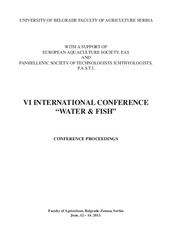Приказ основних података о документу
Dressing percentage of 3-year old carp from cage production system
Randman trogodišnjeg šarana iz kaveznog sistema uzgoja
| dc.creator | Aleksić-Agelidis, Aleksandra | |
| dc.creator | Ljubojević, Dragana | |
| dc.creator | Babić, Jelena | |
| dc.creator | Lujić, Jelena | |
| dc.creator | Novakov, Nikolina | |
| dc.creator | Marković, Maja | |
| dc.date.accessioned | 2024-04-15T09:14:09Z | |
| dc.date.available | 2024-04-15T09:14:09Z | |
| dc.date.issued | 2013 | |
| dc.identifier.isbn | 978-86-7834-155-7 | |
| dc.identifier.uri | https://vet-erinar.vet.bg.ac.rs/handle/123456789/3830 | |
| dc.description.abstract | Carp (Cyprinus carpio L.) is domesticated in every continent except Antarctica, owing to its ability in adapting to different values of water quality parameters, including tolerance to very low dissolved oxygen concentrations. Considering the benefits that are reflected by the extensive reproductive abilities, breeding and prime selection potentials, and high resistance to various diseases, it is not surprising that carp represents the dominant species in all counties with prerequisites for extensive, semi-intensive and intensive freshwater fish production. The carp growth in different production systems depends on many factors, such as varietal, density, welfare and fish feed with proper nutrients along with geographic location. Cage production system for carp is a special type of intensive production. It is characterized by lower initial investments in cage construction and minimal labor engagement, ensuring high production yield per volume capacity of water contained in the constructed units. Modern cages are constructed from metal and synthetic polymers (Mihailovic et al., 2007). Cage has to be robust enough to endure associated hazards such as winds and waves, uncomplicated servicing and maintenance. Location choice is critical as it affects the production and mortality of the produce (Carp) directly impacting the profitability of the production unit. Below listed are three-selection criterion considered for selection of sites for cage culture (Bogut et al., 2007). 1. Physical and chemical parameters including temperature, dissolved oxygen concentration, water flow, pollution and algal blooms. 2. Factors relating to the choice of location taking into account weather conditions, shelter, substrate, water currents and the degree of blur. Additionally the shape and size of the cage and the depth to which they are installed. 3. Profitability of the farm, and includes legal aspects, accessibility, facilities, security, economic and social conditions. Superior production practices, quality of water and optimally balanced diet appropriate for the cultured carp category, expected mortality rate is 1-5%. Compared to other breeding systems, it was found that the cage system morbidity and mortality could vary significantly in the case of deviation in the values of water quality parameters from the optimum, the losses can occur quickly and be dramatic. (Orajić et al., 2007) Shortcoming of cage production system is reflected through allowing of disease transmission and aquatic ecosystems contamination where the cage system is set up, this can be prevented by protective systems introduction. Modern market demands are increasingly directed towards processed fish, especially fillets (Hough, 1993; Vallod, 1995). By removing the skin, internal organs and intramuscular bones, fillets of carp and other cyprinids grown in polyculture along with the carp, become high value meals that are easily and quickly prepared (Lin et al., 1989). Dressing percentage of fish is an economic parameter with significant value attached to it, in all technological operations related to fish processing. It is expressed as the ratio of the primary processed carcass (dressed) relative to carcass weight of live fish. The ratio of edible and non-edible part of the fish carcass can vary significantly depending on the species, weight, size of the fish and season catch (Baltic and Teodorović, 1997). Since the dressing percentage directly influences the economy (profitability) of production, it is unjustly neglected as the parameter in scientific research/studies (Ljubojević et al, 2012). The difference in yield of different lines and their hybrids occur due to different body shape, head length, width and fat of the body. Dressing percentage of fish is significantly higher comparatively than the yield of other animal species (Ćirkovic et al., 2002). Parts that are rejected may include all or some parts of the head, scales, skin, intestine, gonads and fins. According to Dunhamu et al. (1983) fish carcass primary handling involves removal of the head, scales and internal organs, while Lovell (1981) reference states that primary treatment involves the removal of skin, dorsal and pectoral fins, head and abdominal organs cavity, with the tail present. Naumovski (1991) and Tumbas (1976) define fish carcass primary handling as a process which include removal of the tail fin. In this study, yield was determined as the ratio of the fish weight and the carcass without the head, scales, fins and internal organs. | sr |
| dc.language.iso | en | sr |
| dc.publisher | Belgrade : Faculty of Agriculture | sr |
| dc.relation | info:eu-repo/grantAgreement/MESTD/Technological Development (TD or TR)/31011/RS// | sr |
| dc.rights | openAccess | sr |
| dc.rights.uri | https://creativecommons.org/licenses/by/4.0/ | |
| dc.source | VI International Conference Water & Fish, Belgrade, June, 12 - 14. 2013 | sr |
| dc.title | Dressing percentage of 3-year old carp from cage production system | sr |
| dc.title | Randman trogodišnjeg šarana iz kaveznog sistema uzgoja | sr |
| dc.type | conferenceObject | sr |
| dc.rights.license | BY | sr |
| dc.citation.spage | 429 | |
| dc.citation.epage | 435 | |
| dc.description.other | Conference Proceedings | sr |
| dc.identifier.fulltext | http://veterinar.vet.bg.ac.rs/bitstream/id/11467/bitstream_11467.pdf | |
| dc.identifier.rcub | https://hdl.handle.net/21.15107/rcub_veterinar_3830 | |
| dc.type.version | publishedVersion | sr |

